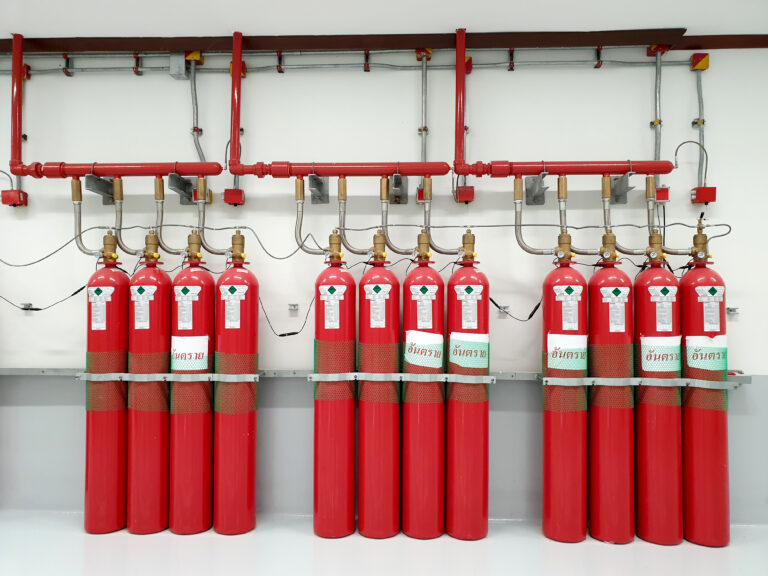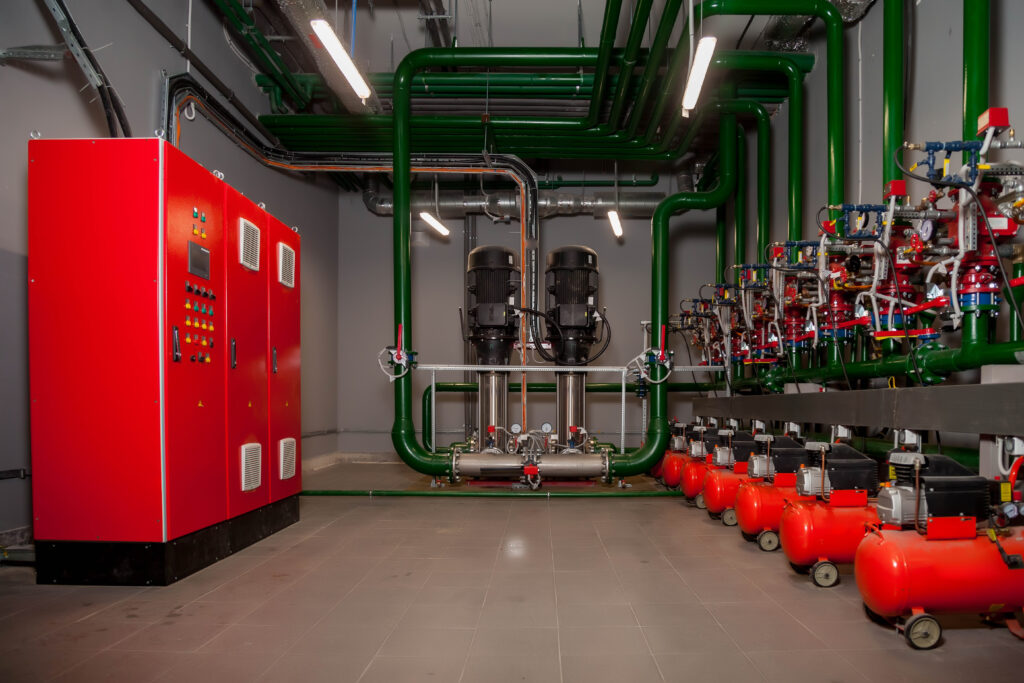FM200 vs. CO2 Suppression Systems: Which One Should You Choose?
Table of Contents
Protecting critical assets from fire is vital for industrial facilities, data centers, and specialized environments, where water-based systems cause more harm. Gas-based suppression systems like FM200 (clean agent) and CO2 (Carbon Dioxide) are key solutions. Choosing between them is complex, as they differ in operation, advantages, disadvantages, risks, and regulatory needs.
This guide will compare FM200 and CO2 to help facility managers, engineers, and business owners select the optimal fire suppression system for their specific requirements, ensuring robust protection and peace of mind.
Understanding Fire Suppression Fundamentals
Before discussing the specifics of FM200 and CO2, it’s essential to grasp the basic principles of fire suppression, especially in environments where water is unsuitable. Fire requires three elements to exist: fuel, oxygen, and heat—often referred to as the ‘fire triangle’. Remove any one of these elements, and the fire will be extinguished.

The Fire Triangle & How Suppression Works
Traditional suppression methods like water primarily work by cooling the heat element of the triangle. However, in environments with sensitive electronics, valuable documents, or certain chemicals, water can cause irreparable damage or even exacerbate the fire (e.g., reacting with certain metals). This is where gaseous suppression systems come into play.
Gaseous Suppression Explained
Gas-based fire suppression systems typically work by either:
- Oxygen Displacement: Reducing the oxygen concentration in the protected area below the level required to support combustion (usually below 15-16%). CO2 is a primary example of this method.
- Heat Absorption/Chemical Inhibition involves interfering with the chemical reaction of the fire itself or absorbing heat energy. Clean agents like FM200 work predominantly this way.
Understanding these fundamental mechanisms is key to appreciating the differences in application, effectiveness, and safety between FM200 and CO2 systems.
Deep Dive into FM200 (HFC-227ea)
FM200, chemically known as Heptafluoropropane (HFC-227ea), is one of the most widely recognized and utilized ‘clean agents’. The term ‘clean agent’ refers to electrically non-conductive, volatile, or gaseous fire extinguishants that do not leave a residue upon evaporation. This characteristic makes them ideal for protecting sensitive equipment and valuable assets.

What is FM200 and How Does it work?
FM200 is stored as a liquid under pressure and discharged as a gas. Its primary extinguishing mechanism is the heat absorption from the fire at a molecular level. It interferes with the chemical reaction that sustains combustion. While it does have a minor effect on oxygen concentration, its primary mode of action is thermal absorption and chemical interference.
When discharged, FM200 rapidly reduces the flame’s temperature, breaking the combustion chain reaction almost instantaneously. This rapid action is one of its most significant advantages. The system typically achieves extinguishing concentration in 10 seconds or less.
Key Advantages of FM200
The benefits of FM200 are particularly evident in specific environments:
- Speed: Extinguishes fires quickly (within 10 seconds), minimizing damage and downtime.
- Personnel Safety: FM200 is designed for occupied spaces. At design concentrations (typically 7-8%), it is considered safe for human exposure, allowing occupants time to evacuate before or during discharge. It does not significantly reduce oxygen levels to hazardous concentrations.
- No Residue: Being a clean agent, it leaves no residue, dust, or water behind. This means minimal cleanup is required after discharge, significantly reducing downtime and potential damage to sensitive electronics or materials.
- Minimal Storage Footprint: Requires relatively less storage space than other agents for the exact protected volume.
- Effective on Class A, B, and C Fires: Capable of suppressing fires involving ordinary combustibles (A), flammable liquids (B), and electrical equipment (C).
Typical Applications
Given its safety profile and clean nature, FM200 is the preferred choice of clean agent systems for many sensitive and occupied spaces. Common industry use case fire system applications include:
- Data Centers and Server Rooms (which are used for data centers)
- Telecommunications Facilities
- Control Rooms
- Museums and Archives
- Medical Facilities
- Process Control Rooms
- Electrical Switchgear Rooms
- Clean Rooms
- Marine and Offshore Applications (Engine Rooms, Control Rooms)
- Financial Institutions
Limitations and Considerations
While highly effective and safe for occupants, FM200 does have some drawbacks:
- Cost: Generally more expensive than CO2 systems for the agent and the initial installation.
- Environmental Impact: As an HFC (Hydrofluorocarbon), FM200 has a relatively high Global Warming Potential (GWP). While it doesn’t harm the ozone layer, its GWP means its long-term use is subject to international regulations (like the Kyoto Protocol amendments) aimed at phasing down HFCs.
- Replenishment Cost: Recharging the system after discharge can be costly due to the agent’s price.
Deep Dive into CO2 Suppression Systems
Carbon Dioxide (CO2) has been used as a fire extinguishing agent for decades. It’s a colorless, odorless, and electrically non-conductive gas naturally present in the atmosphere, although at much lower concentrations than required for fire suppression.
What is CO2 Suppression and How Does it Work?
CO2 fire suppression systems work primarily by reducing the oxygen concentration in the protected area below the level required to sustain combustion. Standard fire extinguishing concentrations for CO2 systems are typically between 34% and 75%, depending on the type of hazard (surface fire vs. deep-seated fire).
CO2 is stored in high-pressure cylinders as a liquid or in low-pressure refrigerated tanks. When discharged, it rapidly expands into a gas, displacing oxygen. While it does have a minor cooling effect, its main extinguishing power comes from suffocating the fire by oxygen deprivation.
Key Advantages of CO2
CO2 systems offer distinct benefits, particularly in specific industrial settings:
- Effectiveness on Deep-Seated Fires: CO2 is particularly effective at penetrating and extinguishing deep-seated fires where other agents might only extinguish surface flames.
- Cost-Effectiveness: Generally less expensive than clean agent systems like FM200, both in terms of the agent and potentially the initial installation (though system complexity varies).
- No Residue: Like clean agents, CO2 is a gas and leaves no residue after discharge, eliminating cleanup costs associated with water or foam systems.
- Electrically Non-Conductive: Safe for use around electrical hazards.
- Readily Available: Carbon dioxide is a widely available commodity.
Typical Applications
Due to its method of operation and safety hazards, CO2 systems are typically used in areas that are usually unoccupied or where personnel can be reliably evacuated before discharge. Common industry use case fire system applications include:
- Industrial Processes (e.g., printing presses, dip tanks, spray booths)
- Flammable Liquid Storage Areas
- Electrical Substations and Power Generation Facilities
- Generator Rooms
- Marine Applications (Engine Rooms, Cargo Holds – often total flooding)
- Mining Operations
- Warehouses (specific hazards)
- Ducts and Extraction Systems (local application)
Significant Limitations and Safety Concerns
The primary and most critical limitation of CO2 suppression systems is their significant danger to human life. This is a key factor when considering CO2 is dangerous to humans:
- Asphyxiation Risk: At the high concentrations required to extinguish fire (34-75%), CO2 rapidly reduces oxygen levels to life-threatening concentrations (below 15%).
- Personnel Hazard: Because of the asphyxiation risk, CO2 systems absolutely must be used in conjunction with robust safety measures, including extensive audible and visual alarms, pre-discharge delays to allow for evacuation, and locked doors or interlocks to prevent accidental entry during discharge.
- Cold Hazard: When discharged, liquid CO2 expands rapidly, converting to gas and dry ice particles. This causes a significant temperature drop and, upon direct contact, can cause frostbite or cold burns

Direct Comparison: FM200 vs. CO2
Now that we’ve examined each system individually, let’s compare them side-by-side to highlight the key differences and help clarify which clean agent system is better for specific scenarios than CO2.
Extinguishing Mechanism: Heat Absorption vs. Oxygen Displacement
This is the most fundamental difference and dictates their suitability and safety profiles. How FM200 and CO2 work is vastly different:
- FM200: Primarily chemical and physical (heat absorption). It interferes with the fire’s reaction chain and cools the flame. It extinguishes quickly with minimal oxygen reduction.
- CO2: Primarily physical (oxygen displacement). It reduces the oxygen level below the point of combustion. This is highly effective but creates a lethal atmosphere for humans.
Safety and Personnel Hazard
This is the most critical distinguishing factor and answers the question, is CO2 dangerous to humans emphatically:
- FM200: Safe for use in normally occupied spaces at design concentrations. Poses minimal risk to human health during discharge, allowing for evacuation time.
- CO2: Highly hazardous to human life due to asphyxiation risk at extinguishing concentrations. Must be used in areas that are unoccupied or can be reliably evacuated and secured during discharge. Requires extensive safety protocols and interlocks.
Suitable Applications
Where you need fire suppression is a significant determinant:
- FM200 is ideal for protecting high-value assets and sensitive equipment in occupied or frequently accessed areas like data centers (which suppresses for data centers), control rooms, museums, archives, and telecommunications hubs.
- CO2: Best suited for unoccupied spaces or areas with specific hazards where human presence is minimal or strictly controlled, such as industrial process equipment, flammable liquid storage, generator rooms, and electrical substations. Effective on deep-seated fires that FM200 might struggle with.
Cost Comparison
Budget is always a factor, though it shouldn’t be the sole one:
- FM200: The agent’s initial cost is higher, as are potentially the system components and installation. Replenishment is also more expensive.
- CO2: Lower initial cost for the agent. System costs can vary depending on complexity (total flooding vs. local application). Generally considered more cost-effective for larger, unoccupied hazards.
Environmental Impact
Sustainability is an increasing concern:
- FM200: Has a high Global Warming Potential (GWP), contributing to climate change if released. Subject to phase-down regulations globally. Newer agents with lower GWP are alternatives, but FM200 is still widely used and compliant with current laws in many areas.
- CO2: While a greenhouse gas, CO2 used in suppression systems is often sourced from industrial processes as a byproduct. Its release during suppression is generally considered a minor contribution compared to industrial emissions.
Regulatory Compliance
Adhering to standards is non-negotiable:
- FM200: Governed by standards like NFPA 2001 (Standard on Clean Agent Fire Extinguishing Systems) and relevant national standards (NFPA vs BIS suppression). Compliance focuses on proper design, installation, agent concentration, and system integrity.
- CO2: Governed by standards like NFPA 12 (Standard on Carbon Dioxide Extinguishing Systems) and national standards. Compliance is stringent regarding safety measures, pre-discharge alarms, delays, signage, and interlocks to mitigate the severe hazard to life.
System Design & Installation Considerations
The physical setup differs:
- FM200: Requires a clean agent container, piping network, nozzles, detection system, and control panel. Piping design (suppression system operation) is crucial to ensure rapid and even distribution of the agent.
- CO2: Also requires containers (often larger or more numerous than FM200 for the same volume due to the higher concentration needed), piping, nozzles, detection, and a control panel. Local application systems have different design requirements than total flooding systems.
Making the Right Choice: Factors to Consider
Choosing between FM200 and CO2 is rarely straightforward. It involves weighing each system’s technical capabilities against the unique characteristics and requirements of your specific application. As a facility manager, fire insights source, considering all angles is vital.
Risk Assessment & Asset Value
What are you protecting, and what is its value?
- High-Value, Sensitive Assets (Electronics, Data, Documents): FM200’s clean, non-damaging discharge and minimal downtime make it the preferred choice, especially in places like data centers (which require suppression for data centers).
- Assets Tolerant of CO2 Discharge (e.g., industrial machinery, electrical gear): CO2 might be considered, especially if cost is a primary driver and human occupancy is not a factor.
Occupancy & Personnel Safety
Are people present in the protected area, and how often?
- Occupied Spaces (Offices, Control Rooms, Labs, Data Centers): FM200 or other clean agents are strongly recommended due to their safety profile.
- Unoccupied or Restricted Access Areas: CO2 can be a viable option, provided rigorous safety measures are implemented and maintained to prevent personnel exposure.
Type of Fire Hazard
What kind of fires are most likely?
- Surface Fires (Flammable liquids, electrical fires): Both FM200 and CO2 are effective. FM200 acts faster on Class A and B surface fires by interrupting the reaction.
- Deep-Seated Fires (Smoldering materials): CO2 is generally more effective at penetrating and extinguishing these fires due to its oxygen displacement mechanism.
Environmental Regulations & Future Proofing
What are the current and future environmental policies?
- Consider FM200’s GWP and the regulatory landscape regarding HFC phase-downs. While currently compliant, future regulations might favor agents with lower environmental impact (clean agent suppression guide).
- Ensure compliance with national standards (NFPA vs BIS suppression) and any recent or upcoming CO2 compliance changes in India that might affect system design or safety requirements.
Budget & Long-Term Costs
Look beyond the initial purchase price (fire system cost calculator).
- Consider installation costs (potentially higher for FM200 piping tolerances, or higher for CO2 due to extensive safety systems).
- Agent cost and potential recharge costs.
- The cost of potential business interruption and damage from discharge (potentially lower with FM200).
- Ongoing maintenance and testing costs (required for both).
Conclusion
FM200 and CO2 are gas-based fire suppression systems for critical assets. FM200 is ideal for occupied spaces and sensitive equipment (like data centers) due to its rapid, clean, and people-safe discharge, despite higher costs and GWP.
CO2 is effective and cost-efficient for unoccupied industrial areas and deep-seated fires. However, its oxygen displacement method poses a severe risk to human life, requiring strict safety protocols and limiting its use.
The optimal choice prioritizes life safety, asset protection, compliance (e.g., NFPA, BIS, and any specific CO2 compliance changes in India), and cost-effectiveness, requiring thorough risk assessment and expert consultation.
Consult SRJ Piping India for expert fire suppression system selection, design, and installation tailored to your specific industrial or critical asset protection needs. Our experienced team can help you navigate the complexities of FM200, CO2, and other suppression options to ensure you have the most effective and compliant system.
Choosing between FM200 and CO2 fire suppression systems isn’t just technical – it’s a life-or-death business decision with lasting financial implications. The NFPA 2001 Standard reveals FM200’s 10-second discharge advantage over CO2 in server rooms, while OSHA 1910.162 mandates CO2’s strict safety protocols for industrial use – a dichotomy we navigate daily through our FM Global-Compliant Design Services. When a Bangalore data center’s CO2 system accidentally activated (per this CSB Incident Report), it validated our Pre-Action System Solutions for mission-critical environments. Your choice hinges on three factors: asset sensitivity, occupancy patterns, and total cost of ownership – all decoded in this definitive guide.
FM200 or CO2 – Not Sure What Your Facility Needs?
Our fire safety experts at SRJ Piping India help you choose the right gas suppression system—safe, compliant & cost-effective.
